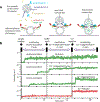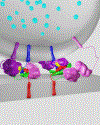Molecular Mechanisms of Fast Neurotransmitter Release
- PMID: 29792815
- PMCID: PMC6378885
- DOI: 10.1146/annurev-biophys-070816-034117
Molecular Mechanisms of Fast Neurotransmitter Release
Abstract
This review summarizes current knowledge of synaptic proteins that are central to synaptic vesicle fusion in presynaptic active zones, including SNAREs (soluble N-ethylmaleimide sensitive factor attachment protein receptors), synaptotagmin, complexin, Munc18 (mammalian uncoordinated-18), and Munc13 (mammalian uncoordinated-13), and highlights recent insights in the cooperation of these proteins for neurotransmitter release. Structural and functional studies of the synaptic fusion machinery suggest new molecular models of synaptic vesicle priming and Ca2+-triggered fusion. These studies will be a stepping-stone toward answering the question of how the synaptic vesicle fusion machinery achieves such high speed and sensitivity.
Keywords: Ca2+ triggering; action potential; fusion protein; synaptic vesicle fusion; synaptic vesicle priming.
Figures








References
-
- Araç D, Chen X, Khant HA, Ubach J, Ludtke SJ, et al. 2006. Close membrane-membrane proximity induced by Ca2+-dependent multivalent binding of synaptotagmin-1 to phospholipids. Nat. Struct. Mol. Biol 13(3):209–17 - PubMed
-
- Augustin I, Rosenmund C, Südhof TC, Brose N. 1999. Munc13–1 is essential for fusion competence of glutamatergic synaptic vesicles. Nature 400:457–61 - PubMed
Publication types
MeSH terms
Substances
Grants and funding
LinkOut - more resources
Full Text Sources
Other Literature Sources
Miscellaneous

